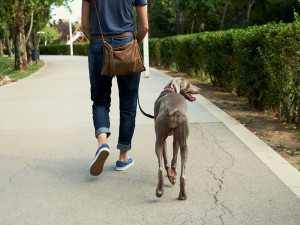8 Hands-Free Dog Leashes for Running (or Texting)
Remember to stay alert!

Share Article
I never thought I’d be the type of person to wake up at 6 a.m. for a jog, but my dog, Banshee, loves to exercise, and she’s an early riser, so it’s become part of the routine — the things we do for our kids. Beyond my less-than-middling cardiac fitness and her dedication to spontaneous bowel movements, there have been some challenges. The Banch’s enthusiasm has an unfortunate tendency to manifest itself in the form of zig-zagging from one side of me to the other — not to mention that I need to carry a large water bottle to battle my previously stated weak heart. After some minor Googling, one solution presented itself: a hands-free leash.
Of course, like any cautious parent, I asked a doctor before trying something new. “The hands-free leash only works well if the dog knows how to heel properly. If the dog is not good on a regular leash, they’re probably not going to be good on a hands-free leash,” says veterinarian and Kinship Collective member Dr. John Iovinoopens in a new tab.

littleKin™ is Kinship’s home just for puppy and kitten parents. Bop over to check out expert advice, new pet tools, and special deals—all curated for your newest family member.
opens in a new tabHe notes that while hands-free leashes can be a great option for many dog parents, there are a few stipulations to consider. If a dog is erratic or aggressive with a standard leash, they will still require the same attention with a hands-free option and the possible hazards will likely be more severe.
Length is also a key consideration, especially for jogging. Dr. Iovino recommends using a shorter leash to help secure the dog to your side for the duration of the exercise; but it’s not just the dog’s safety you should consider. “I think having something around your lower back with a dog, especially if it’s a larger dog, I can definitely see that becoming a potential for injury,” warns Dr. Iovino.
There are two methods of strapping a hands-free leash to yourself. You can either strap it over the shoulder or wear it around your waist. While he gives a slight edge to the off-the-shoulder option for safety reasons, Dr. Iovino cautions both can cause possible back damage. And the bigger the dog, the bigger the risk.
All that being said, if your dog is well-behaved on a leash and you are actively aware of your surroundings throughout, Dr. Iovino agrees a hands-free leash could be a great option for walking, running, or even hiking. Below, the best leashes that’ll afford you the ability to hold a drink, eat food, or document the entire experience for Instagram while you do it.
Btw, our editors (and their pets) picked out these products. They’re always in stock at the time we publish, but there’s a chance they’ll sell out. If you do buy through our links, we may earn a commission. (We’ve got a lot of toys to buy over here, you know?)

Sean Zucker
Sean Zucker is a writer whose work has been featured in Points In Case, The Daily Drunk, Posty, and WellWell. He has an adopted Pit Bull named Banshee whose work has been featured on the kitchen floor and whose behavioral issues rival his own.
Related articles
![A woman feeding her dog a treat while on a hike.]() opens in a new tab
opens in a new tabWhy Your Dog Needs a Martingale Collar
For starters, it prevents escape, works as a training tool, and is recommended by rescue workers.
![A person walking a dog on a paved road in a park.]() opens in a new tab
opens in a new tab4 Ground Rules for Good Dog Walking Etiquette
Your neighbors will thank you.
- opens in a new tab
How to Manage Leash Reactivity in Your Dog
If your pup acts diabolical on walks, you are not alone. Here’s what you can do.
![Dog lying on a brick street with a leash]() opens in a new tab
opens in a new tab“Why Won’t My Dog Walk Outside?”
Dog behaviorist Karen B. London’s 7 tips to help get your parked pet moving.
![French bulldog smiling with blue harness]() opens in a new tab
opens in a new tabStrap in: Dog Collars vs. Harnesses
Style and safety don’t have to be mutually exclusive (phew).












